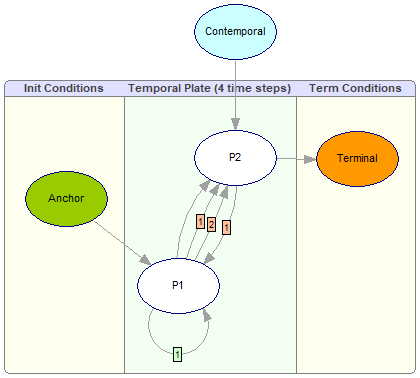A dynamic Bayesian network (DBN) is visualized in GeNIe with a temporal plate. The structure of the DBN shown below (as a GeNIe screenshot) does not represent any real system; it was created solely for demonstration purposes.

The temporal plate divides the graphical layout of the network into four categories of nodes. These categories correspond to four temporal node types in SMILE:
•CONTEMPORAL: Nodes that do not change over time.
•ANCHOR: Nodes outside the temporal plate that have one or more children inside the plate. Anchor nodes are similar to contemporal nodes, but they are only connected to nodes (their children) in the first time slice of the network. In GeNIe, anchor nodes are displayed in the Init Conditions panel on the left-hand side of the temporal plate.
•PLATE: Nodes located inside the temporal plate that may have incoming and/or outgoing temporal arcs. They are displayed in the Temporal Plate panel, which also indicates the number of time slices used during inference.
•TERMINAL:Nodes outside the temporal plate that have one or more parents inside the plate. Terminal nodes are connected only to nodes (their parents) in the last time slice of the network. They are displayed in the Term Conditions panel on the right-hand side of the temporal plate.
Use Network.set_node_temporal_type and get_node_temporal_type to modify or retrieve a node's temporal type.
Python
get_node_temporal_type(node: int | str) -> int
set_node_temporal_type(node: int | str, temporal_type: int) -> None
Java
int getNodeTemporalType(int nodeHandle);
int getNodeTemporalType(String nodeId);
void setNodeTemporalType(int nodeHandle, int temporalType);
void setNodeTemporalType(String nodeId, int temporalType);
C#
int GetNodeTemporalType(int nodeHandle);
int GetNodeTemporalType(string nodeId);
void SetNodeTemporalType(int nodeHandle, int temporalType);
void SetNodeTemporalType(string nodeId, int temporalType);
R
temporalType <- net$getNodeTemporalType(nodeIdOrHandle)
net$setNodeTemporalType(nodeIdOrHandle, temporalType)